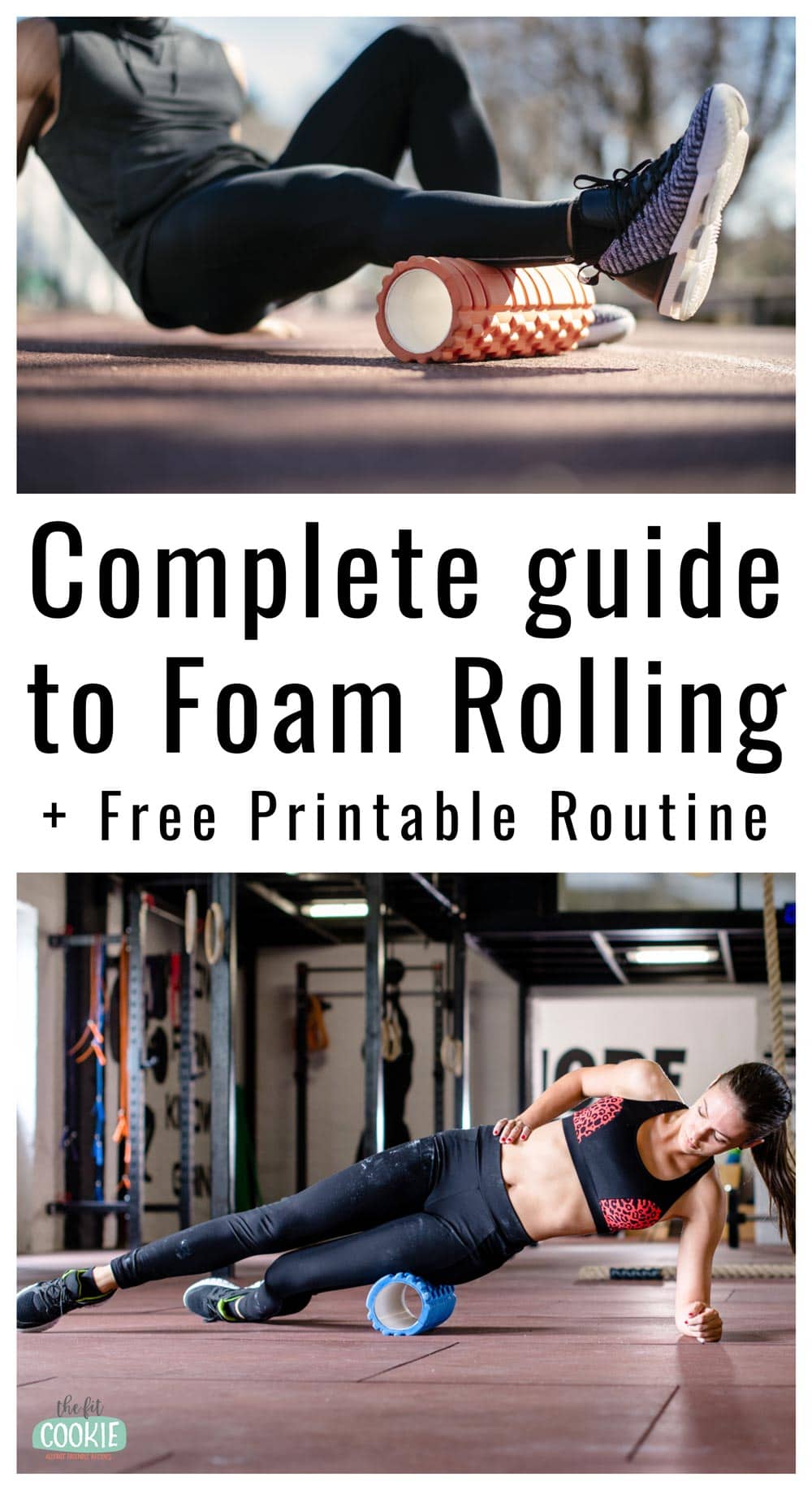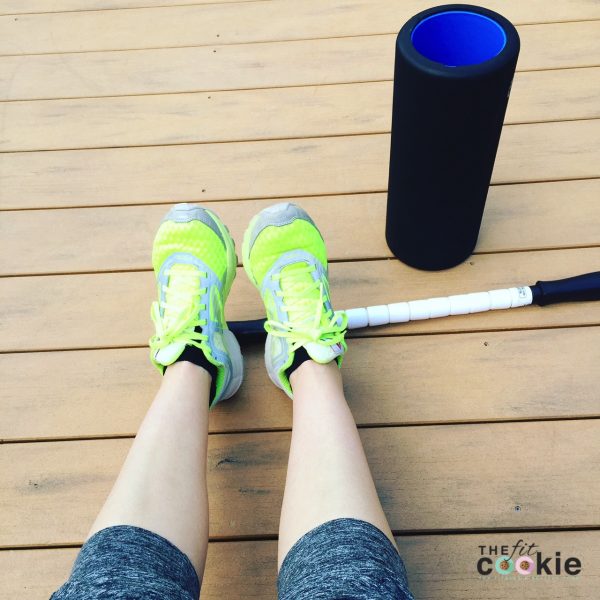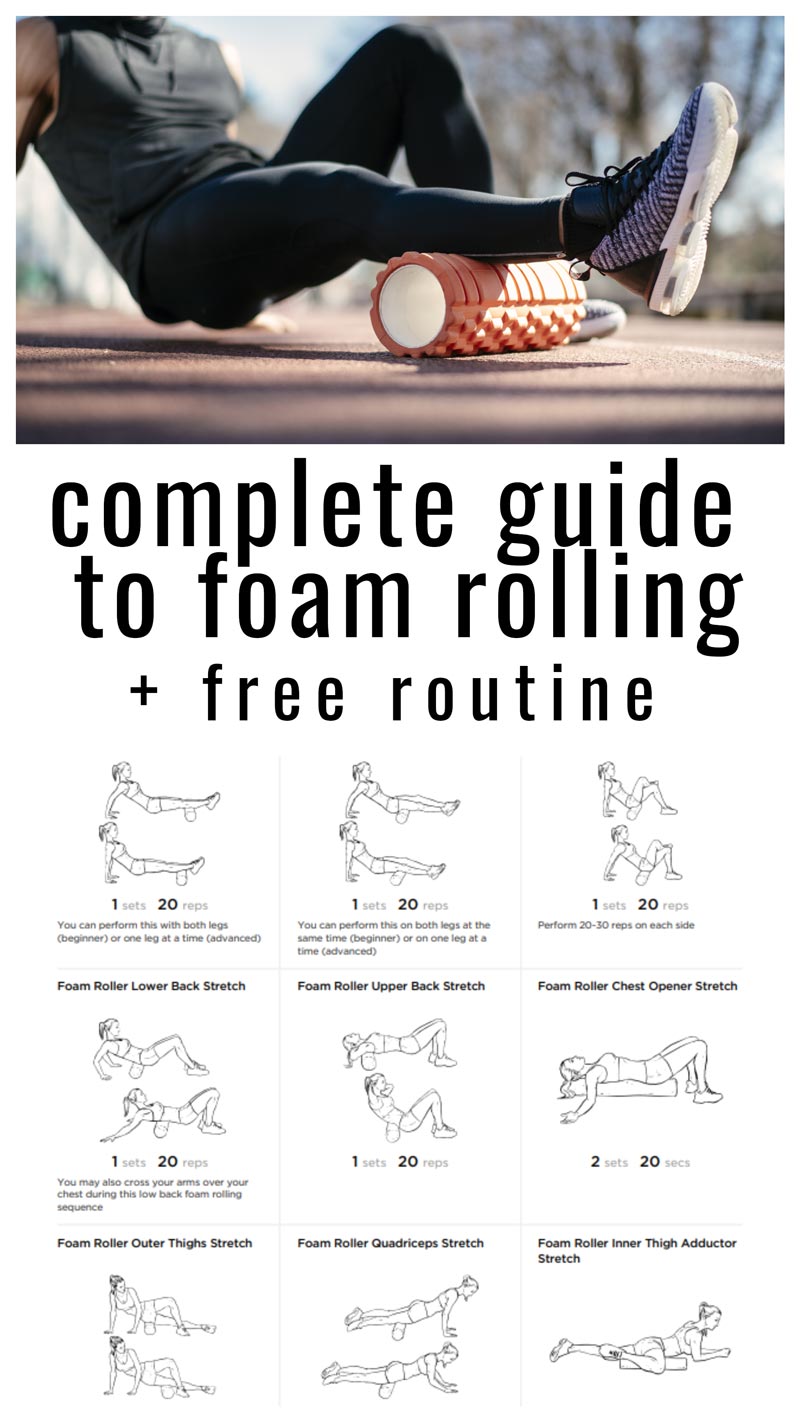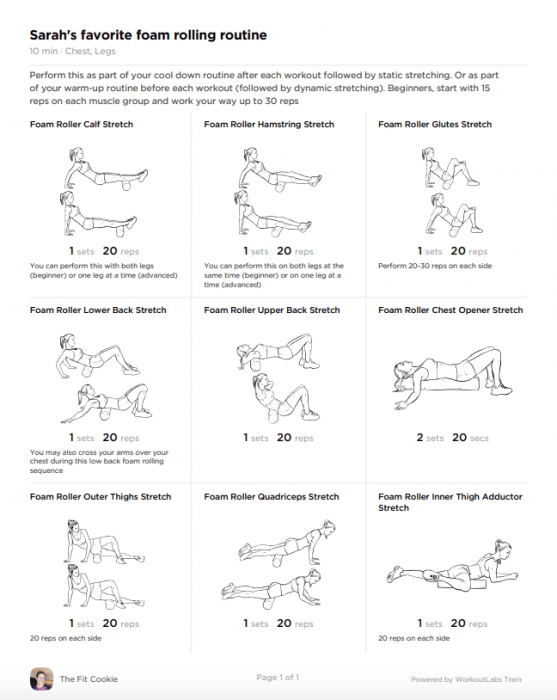Want to improve your range of motion, athletic performance, and reduce muscle soreness after workouts? Get rolling! Read all about foam rolling in our complete guide, including benefits of foam rolling and our own favorite rolling routine you can print and save.

By Sarah Jane Parker, ACSM cPT, ACE Health Coach, Revo2lution Running Certified running coach, YogaFit certified instructor, ACE Fitness Nutrition Specialist
You probably know the feeling: getting an awesome workout, skipping the cool down because you don’t have time, then waking up stiff and sore the next few days.
If you don’t know what that feels like, you’re probably one of the few very lucky people who don’t experience DOMS (delayed onset muscle soreness)! I am not one of those folks: if I skip my warm up or cool down with stretching and foam rolling, I get achy, my muscles get stiff, and I get tons of knots and adhesions. Not fun.
We pay attention to building our muscles in the gym, but we can’t neglect regenerating our muscles, and that includes taking care of our body’s fascia and connective tissue network.


Stretching and massage aren’t the only things that can help with keeping muscles and connective tissue pliable. Foam rolling and self myofascial release (SMR) are also great ways to keep your range of motion where it should be.
Here’s a quick table of contents for our article:
- What is fascia and SMR?
- Why use a foam roller?
- Is rolling really all that great (and what research says about foam rolling)
- Contraindications: who should avoid foam rolling and SMR
- How to add foam rolling and SMR to your workouts
- My favorite foam rolling routine (with printable PDF)
What is fascia and SMR?
Making time to stretch and foam roll either before or after workouts (or both) can help to lengthen muscles, hydrate your connective tissue (source), and loosen up scar tissue adhesions in muscle and connective tissue that can cause misalignments and range of motion limitations.
Foam rolling (along with cupping) is a type of muscle and tissue massage called Self Myofascial Release (SMR). Self myofascial release is a self-directed myofascial release similar to deep tissue massage that is intended to keep fascia and muscles elastic to bring the body into proper mechanical alignment (source).
Fascia are large sheets of connective tissue connecting muscles, bones, and joints. Sometimes due to repetitive exercise, poor posture habits, or lack of hydration, our fascia sticks to itself or sticks to muscle tissue near it (source).
Often times those sticking places (scar tissue or adhesions) turn into trigger points, areas in soft tissue that are painful to the touch and inflamed. The once flexible tissue becomes replaced with stiff scar tissue that can lead to reduced range of motion resulting in mechanical imbalances and sports injuries.
The causes of trigger points can include physical injury, poor nutrition, improper body mechanics, over training, and not getting the proper rest between training sessions.
Trigger points can also be caused by both poor body mechanics, and can also cause poor body mechanics, resulting in a perpetual cycle of injury and muscular imbalances if they are not addressed.
Through self myofascial release, an individual can help to hydrate connective tissue and loosen up scar tissue and adhesions, allowing for better range of motion, and reduction of muscle pain and soreness.
Why use a foam roller?
Using a foam roller in for self myofascial release is a convenient way for people to do their own type of deep tissue massage.
Foam rollers are an ideal tool for implementing self myofascial release because they are inexpensive, they do not require the assistance of a second person, and they are available in travel sizes.


Foam rollers are widely available at many stores and come in different densities. Beginners should use the softer low-density rollers that will not cause too much pressure on trigger points but will still deliver an effective myofascial release.
Advanced users can usually tolerate the higher density foam rollers, but always talk to your doctor or physical therapist and use your tolerance as a guide.
Many gyms have their own foam rollers that people can use too, but if you are concerned about sharing germs or want to do your rolling at home, invest a little cash and buy your own roller. They are usually pretty affordable and widely available.
Some of the different types of foam rollers on the market today:
- Vibrating foam rollers
- Heated foam rollers
- Foam rollers with grooves
- Knobby “rumble” rollers (usually too intense for beginners)
- Collapsible travel rollers
- Water bottle foam rollers
- Foam rollers with straps and storage.
Other great SMR tools:
- Theracane
- Trigger point ball, tennis ball or racket ball
- Massage stick
- Cupping therapy sets (provides SMR through myofascial decompression)
- Graston tools (used by a physical therapist)
- Percussion massagers (aka massage guns)
Is rolling really all that great? What research says about foam rolling
You might have read in recent years about people not recommending foam rolling. They say it is too harsh on your body and too compressive to your tissues, causing them to stick together even more.
If this were the case, then deep tissue massage (or even regular massage) as well as physical therapy would not be beneficial to the body. But we see anecdotal and research evidence to show that this is simply not the case.
Foam rolling and SMR is beneficial, even if it is uncomfortable at the time (if you are new to SMR, it will be uncomfortable at first). But discomfort doesn’t always mean something is bad, something I’m reminded of every time I go to physical therapy.
What research says about foam rolling and self myofascial release:
- Research has shown that foam rolling can improve joint range of motion when done pre- or post-workout (source).
- One small study has shown that roller massage on hamstrings improved sit and reach range of motion without performance impairments (source).
- Experienced physical therapists regularly incorporate myofascial release in their treatments with great success, based on patient needs.
- Soft tissue work and myofascial release by a physical therapist can be effective for treating plantar fasciitis (source).
- Foam rolling can improve muscle tenderness and soreness in days after workouts done to fatigue (source).
- Foam rolling and other SMR rolling devices help to move fluid through your fascia and connective tissue layers, keeping those tissues hydrated, which is important for proper tissue repair (source).
While there are contraindications (see our notes later in this guide) for who should foam roll and who shouldn’t, most healthy individuals who lead an active lifestyle can benefit from foam rolling and reasonable amounts of SMR.
That said, too aggressive myofascial release can result in pain, bruising, and broken blood vessels if you’re not careful. Don’t get aggressive with your SMR unless you’re under the supervision of a skilled physical therapist!
Some very aggressive types of rollers (like rumble rollers) are not a great idea for the average person. Instead, consider an easier myofascial release protocol like the Melt Method , which uses soft foam rollers to help release and hydrate connective tissue and fascia. This method is very effective!
I attended a Melt Method workshop at an IDEA conference several years ago and was impressed with the reduced soreness and range of motion with just the 1 hour of using the method. I bought the book and need to buy their soft rollers, but it worked great for me on my sore muscles (when my muscles are sore, they scream at me haha).
If you have very tender trigger points and lots of muscle knots like I do, or if you have medical issues like fibromyalgia, the Melt Method with soft rollers is a great idea (make sure to always check with your doctor before beginning any new programs if you have medical conditions!).
Things to keep in mind when foam rolling or using other forms of self myofascial release:
- Always check with your medical provider before beginning anything new, like foam rolling or self myofascial release
- Beginners need to begin rolling (and any SMR) gradually and with soft rollers and tools, and only roll as tolerated and build up to harder or more dense rollers
- Remain consistent with foam rolling and SMR for the best benefits
- Foam rolling will be uncomfortable for most people when they first begin, but this will improve over time as you continue to foam roll
- Discomfort is common, but severe pain is not. Consult a physical therapist or doctor if you have severe pain with foam rolling or self myofascial release.


In spite of some people calling for not foam rolling, from personal experience, I know that foam rolling and myofascial release makes a huge difference for me and many other people.
I get a lot of muscle knots, adhesions, tendinitis, and related problems, so keeping my connective tissue and muscles hydrated and pliable is extremely important for me. Foam rolling is one way I can achieve that, along with regular exercise, physical therapy, massage (when I can afford it), and cupping.
Foam rolling isn’t a cure-all, and it can’t fix everything. Foam rolling has been helpful for me in resolving a lot of tendonitis issues, but in spite of my religious foam rolling routine, I still suffer from tendinitis and bursitis due to my femoral retroversion and exacerbated by bouts of inactivity from recent surgeries.
Contraindications: who should avoid foam rolling and SMR
When choosing to add foam rollers to your workout and stretching routine, it is important to first understand your risk factors before beginning. Women who are pregnant may want to consult their physician first, as well as anyone with chronic illnesses such as arthritis, osteoporosis, or severe varicose veins.
People who bruise easily or have bleeding or clotting disorders should be avoid SMR, as well as those with skin or collagen disorders where their skin can be easily torn should also avoid foam rolling.
In general, if you are in good health, foam rolling and reasonable myofascial release should be fine for you, but always consult your physician before beginning any new workout, fitness routine, or health regime (including myofascial release).
How to add self myofascial release to your workout routine
Foam rollers and other SRM techniques can be used at the beginning of your workout as part of your warm-up and mobility routine, or at the end of your workout as part of your cool down.
Using self myofascial release and foam rolling as part of your warm helps to correct faulty mechanics so you can experience better range of motion during your workout and reduce the risk of injury.
If you choose to foam roll after your workout, this can help release any tension and trigger points that may have developed or been agitated during the workout and aid in post workout stretching.
When using self myofascial release and foam rolling, it’s important to follow proper technique and guidelines. If you are not sure how to use foam rollers or are not comfortable performing this on your own, check with a physical therapist or qualified personal trainer who can give you specific guidance in how to implement self myofascial release suited to your individual needs and conditions.
If you are healthy and physically capable, you can follow these general guidelines:
General guidelines for foam rolling:
- For each muscle and muscle group, roll on the foam roller about 20-30 times, or spend 1-2 minutes on each muscle group, as tolerated. Beginners will have less tolerance for rolling, so only do what you can tolerate and build up to adding more over time.
- When a trigger point (painful area) is found, rest on the trigger point for 30-45 seconds as tolerated.
- Keep your abdominal muscles tight to provide stability to your core during all foam rolling movements.
- Remember to continue to breath in and out in a controlled manner to help to reduce any tense reflexes caused by discomfort.
- Complete the self myofascial release exercises daily, and follow up with stretching
- Foam rolling and SMR is most effective when your muscles are warm
- Use the foam roller along the full length of your muscle, from the point of origination to the point of insertion, and avoid rolling over bony prominences.
- Make sure you roll your muscles in multiple planes and angles as long as you’re not twisting your joints too much. For example: when you’re rolling your calves, you can turn your toes slightly inward and outward to get the outside of your calf muscle and the inside of your calf muscle.
For a comprehensive guide to various SMR techniques for different muscle groups and using different tools, check out this soft tissue SMR guide.
Helpful hint: if you aren’t able to do foam rolling on the floor, you can use the foam roller against the wall to reduce pressure on your body.
Incorporating self myofascial release through the use of foam rollers is an excellent way for athletes to mobilize restricted and tightened ligaments, tendons, and muscles. Foam rolling and SMR is even better when it’s combined with dynamic stretching (before workouts) and static stretching (after workouts)!
This results in better performance and injury prevention by breaking down scar tissue and adhesions, and at same time lengthening and creating more elastic muscles and fascia: better alignment and fewer muscle imbalances!
If you haven’t gotten into foam rolling yet, I highly recommend any healthy fitness enthusiast integrate foam rollers into their daily health routines. Let’s get rolling!
Helpful hint: proper hydration is critical for keeping fascia and other connective tissues moving freely and from sticking together! Stay hydrated to keep your muscles and connective tissue elastic.
My favorite foam rolling routine (and printable!)
Over the years, I’ve created a pretty well-rounded foam rolling routine. When I was running more, I would even do rolling both before and after my runs (like I said, my body can be a knotted mess sometimes).
I put together a routine with my favorite foam roller exercises for my readers! This routine takes about 8-10 minutes, and I would usually follow it up with static stretching. It’s a great idea to combine SMR and stretching together to get the most benefit!
If you decide to do this routine as part of your functional warm-up, you can warm up a little bit with some full-body movement (like rowing, walking, jogging, etc.) for 5-10 minutes, foam roll, then follow it with dynamic stretches.
Click on the image above to print or download your PDF of the foam rolling routine, or click here.
Other useful resources for foam rolling and self myofascial release:
- Perform Better: Using Foam Rollers
- ACE Fitness latest research on fascia
- Oxygen Magazine: Roll Out the Science (the science of foam rolling)
- ACE Fitness: Training the fascial network
Sarah Jane Parker is the founder, recipe creator, and photographer behind The Fit Cookie which she founded in 2011. Sarah is based in Wyoming and has been managing food allergies for herself and her 2 children for over 20 years. Sarah was also a certified personal trainer for 12 years, as well as a group fitness instructor, health coach, running coach, and fitness nutrition specialist.

Hey Sarah, impressed with the detail in this guide. I just got a foam roller so this is really helpful. The problem is after I workout, I’m itching to get out of the gym. If you only had enough time for one, would you choose static stretching or foam rolling?
If you really only have time for one thing, alternate stretching and rolling on alternate days. If you stretch one day, roll the next day, etc. Rolling and stretching go best together, but if you alternate days, at least you’re getting both in a couple times a week 🙂